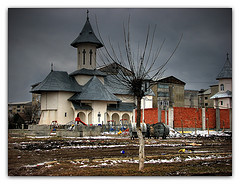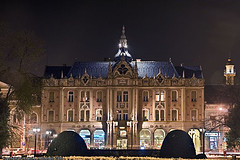

In Chapter I.2, In search for unity: Author looks out window of Aurora Hotel’s Room 214. From the archaic religious imaginary of the Greek-Latin mythology. Onto Satu Mare’s central square. To the modern imaginary. The pavement is damp from a brief shower. We integrate within our proposed approach to the archetype. Which continues to grow stronger. The interpretation of information in Istoria credinţelor şi ideilor religioase. The headlights of autos circling the square counterclockwise at 7:38 pm. In which Eliade aims to demonstrate the unity of the human spirit. Lay down long beams on the asphalt. The Land of Oas arrives through time, like a mountain river. A white car with black racing stripes streaks by much faster than the rest. Flowing through detritus, roots and sunbeams. A yellow bus lumbers past. Such as the Talna, the Tur, the Valea Alba or the Valea Turtului, famous aquatic arteries of the region. Not only the rain, now, but the wind rustles the trees in the square. In the name of this unity, we notice that the author integrates within the religious mythological imaginary. Causing them to sway and so splay their new full branches of foliage. Situated in the north of Romania, it belongs equally to earth and sky, to the tangible and the intangible worlds. The philosophical, scientific, technical and artistic relations that promote new forms, preserving still a religious meaning. Above the trees rise the twin towers. The North Star is like a friendly neighbor. Of a traditional Catholic church. A certainty suspended on the beam or behind the windmill atop the barn.

In Eliade’s view the human spirit, like the sacred, has an ontological value. A silver car passes without its headlights on in a steadily darkening scene. The Land of Oas is a part of the whole that means identity and difference. Whereas in the previous chapter we have represented by means of the four chronotopoi the relation between man and the sacred. A silver taxi, a green light on its roof, circulates with only its parking lights on. It cannot be confused with other regions. In this chapter we aim to emphasize the concepts by means of which Eliade formulates the dynamics of the spirit in history. The park benches are vacant. In either ethnographic, linguistic, folkloric or psychological terms. Diachronically marked by four fundamental experiences: The only pedestrians, heading across the street in both directions, carry umbrellas as suddenly the volume of the rain increases. It is unique. The hunt, agriculture, the imperial policy promoted by Alexander the Great, based upon the concept of oecumene, and the Judeo-Christian valorization of institutionalized history. Unconcealed admiration is a component of its allegiance. A cooler breeze enters the hotel room, where a fly, with an open window available, continues to harass author. The best way to talk about Oas is to level it up to the rank of a feeling or an idea. The traffic slows; thunder sounds; the traffic increases. Its prospective wing arches into the future from a present that is obvious. Suddenly all the cars have their lights on, including the taxi with the green light atop it making its second consecutive circuit of the square.
Many people have written about the region, including contributors to Eminescu’s magazine “Familia.” Referring to Greek mythology, we consider it to be a meeting space of an Indo-European archaic Orient with the Thracians, and of primitive Christianity with the Romano-Germans. Most of the cars circling the square are grey, black, bronze, white or tan. Ion Busita published a series of reports on the Land of Oas. Though here comes a small, dark maroon sedan. So we present the Greek-Latin mythology, which, on the one hand, manifests an archaic character, and on the other hand has been the bedrock of new spiritual works, as the religious substratum of modern civilization. Parked along the curb, however, are cars in brighter colors that repeat themselves: The famous Hungarian composer Bela Bartok recorded musical folklore from. Red, silver and black; red, silver and tan. Comlausa. Black, white and silver; blue, back and red. Tarna Mare. White, black and red; silver, black and red. And Turt. We notice that the same bi-unitary character of the archetype also manifests in the two Greek religions. Two red lights go on beside the entrance to a store. (Olympian and Mystery.) As another yellow bus makes its circuit, much more noisily than do the cars. Rediscovered in Roman religion. Whose only sound from this vantage point comes from their wheels on the dampened pavement. Other composers have studied themes from Oas, and the sculptor Visa Gheza carved a dance from the region. There is no honking of horns whatsoever. While painters have represented its villages.

Author moves his laptop computer from a little table onto a marble window ledge and takes a seat on the little table. We present the internal evolution of Greek-Latin mythology and its accompanying tendency to register expansion and archetypical recurrence of beginnings. This region is unmistakable: The traditional buildings along the near side of the square. A space within a space. Are quite beautiful. Much as every man is a being among beings. If a little provincial. With common features but also personal notes. Above “Bank Leumi Romania” rise the white pilasters and yellow-painted stone walls of a seventeenth-century style three-story building with a garret above. Commenting upon the four Greek cosmogonic myths, their typology and the mythologies of death. Above it in turn are two TV antennae. We notice that the bi-unitary structure of Greek religion is accompanied, in the presence of divinities, by the manifestation in triad, to which specific functions are connected, along with the tendency toward cosmic integration. Oas offers an archaism compatible with modern taste. The next building, which has fancy Romanian capitals atop its pilasters, has been painted mauve. Its spiritual dowry attracts and persuades. Eliade innovates and restructures divinities in the Greek-Latin pantheon. You can find it in the air, cut by the violins of gifted fiddlers. And it is almost entirely obscured. Such as Mihai Tomoc, Ioan Chioreanu or Petre Zele. Except for its orange tiled roof. The Sava brothers, Vasai Macovei and Ion Lichii. By an elliptical tree.

Eliade relates the figures of the gods to these archaic functions, dislocating old hierarchies and highlighting extra dimensions of traditional couples, opting for archaic divinities. But its beauty can be read better from the “strap of the bag,” handwritten by the girls of the Oas. The next building over has four arches above the Ionic capitals topping its pilasters, a triangular architrave above them, and a peaked roof that seems to belong to yet another building but in fact belongs to the building whose facade includes two mansard roofs with oval apertures. This is suggested, in our opinion, by the “totalitarian” tendency of all the presented gods who either belong to an initial triad or “control” the three cosmic areas. With the hands of the soul, from threads dipped in the colors of love. Next to this building rises the Dacia hotel, its roof tiled in blue and surmounted with a turnip shaped pinnacle, atop which is another turnip. So we focus on synchronous relations among “life” mythologies, represented in the official Olympian religion, and “death” mythologies, in the mystery religion. It passes through time in the rhythm of the “dance” incited by the lads who whip the ground till the stars of the sky fall to earth, ennobling it. The sidewalk café in front of the last two of the buildings is nearly vacant, except for two young men. “Hit the floor with your feet, / Until the stars come out,” they cry. We observe their synthesis in new religious creations from a synchronous perspective. It is not clear whether they are customers or employees. We can find it in the circle of pearls or in the plum brandy.

Thus our analysis focuses upon the god Dionysus, the divine child, born of Zeus and the mortal Semele. The sky is lightening, first along the horizon, where a few of the darkest clouds linger, then above, where a middle ground of shadowy blue-grey prevails. Immediately overhead, rain clouds threaten to recommence their activity. We do not know how many rights the girl of Oas had in olden times, but the right to choose the handsome man was inviolable. Dionysus is a god of fertility, nature and vegetation, of vine and wine, of earth, Inferno and hunting, of enthusiasm and divine transport. From our new vantage many red taillights are visible, at the point where cars exit the square. She said no to the swarthy, to the thick lipped, to the worthless. He is a god of metamorphoses, and he presages a new Golden Age. A much cooler (and refreshing) gust blows through the open window. The feminine melancholy folk songs are a testimony. His archetype is represented by persecution, epiphany, occultation and resurrection. A driver in a yellow car leads a pack of half a dozen vehicles into the turn before the Aurora Hotel. The love declarations translated into poetry when the bow of Eros unleashed the blaze and defeated the moral options. One may see in him the unity of existence in its totality. He is cut off by a silver sedan. The unity of life and death. Marriage was until not long ago a law stronger than the Great Wall of China. Which moves to pass him on the inside and speed toward the next turn. The connection is to be found in their sacred and mystery-related essences.
